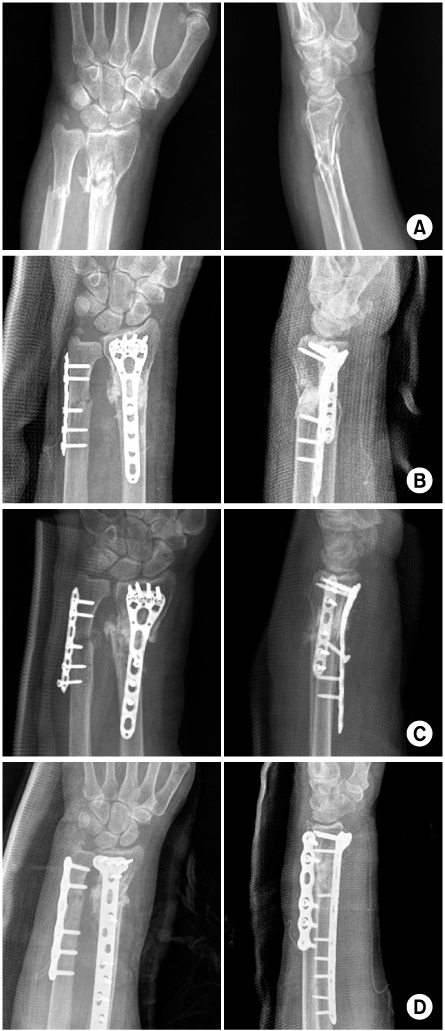J Korean Fract Soc.
2012 Jul;25(3):197-202.
Comparative Analysis of the Results of Fixed-angle versus Variable-angle Volar Locking Plate for Distal Radius Fracture Fixation
- Affiliations
-
- 1Department of Orthopedic Surgery, Myong-Ji Hospital, Kwandong University College of Medicine, Goyang, Korea. hand0123@kd.ac.kr
Abstract
- PURPOSE
To compare the outcomes of distal radius fractures in a fixed-angle volar locking plate group and variable-angle volar locking plate group.
MATERIALS AND METHODS
Forty-one patients observed at least 6 months after surgery were included in this retrospective study. We used the range of motion, visual analogue scale score, Disabilities of the Arm, Shoulder and Hand Questionnaire score, and radiologic findings to measure the clinical results.
RESULTS
No differences in clinical results or radiologic results were noted between the fixed-angle volar locking plate group and variable-angle volar locking plate group.
CONCLUSION
We believe that it is important to minimize complications by using appropriate screws and plates according to the fracture type, though no differences in the surgical outcome were noted between the fixed-angle volar locking plate group and variable-angle volar locking plate group with distal radius fracture.
MeSH Terms
Figure
Reference
-
1. Ark J, Jupiter JB. The rationale for precise management of distal radius fractures. Orthop Clin North Am. 1993. 24:205–210.
Article2. Cho CH, Jung SW, Sohn SW, Kang CH, Bae KC, Lee KJ. Comparison of outcomes for unstable distal radius intraarticular fractures: t-locking compression plate versus external fixator. J Korean Fract Soc. 2008. 21:51–56.
Article3. Choi CH, Jung JH, Lee KH, Sung IH, Son KH. Volar locking T-plate fixation of dorsally displaced unstable distal radius fracture. J Korean Soc Surg Hand. 2005. 10:123–128.4. Herron M, Faraj A, Craigen MA. Dorsal plating for displaced intra-articular fractures of the distal radius. Injury. 2003. 34:497–502.
Article5. Harrison MR, Hamilton S, Johnstone AJ. Pseudo-rupture of Extensor Pollicis Longus following Kischner wire fixation of distal radius fractures. Acta Orthop Belg. 2004. 70:492–494.6. Hastings H 2nd, Leibovic SJ. Indications and techniques of open reduction. Internal fixation of distal radius fractures. Orthop Clin North Am. 1993. 24:309–326.7. Kim JK, Park HS, Jeong BJ. Comparative analysis of the results of dorsally unstable distal radius fractures between kapandji technique and volar locking plate fixation. J Korean Soc Surg Hand. 2008. 13:217–222.8. Lowry KJ, Gainor BJ, Hoskins JS. Extensor tendon rupture secondary to the AO/ASIF titanium distal radius plate without associated plate failure: a case report. Am J Orthop (Belle Mead NJ). 2000. 29:789–791.9. MacDermid JC, Roth JH, Richards RS. Pain and disability reported in the year following a distal radius fracture: a cohort study. BMC Musculoskelet Disord. 2003. 4:24.
Article10. Martineau PA, Berry GK, Harvey EJ. Plating for distal radius fractures. Orthop Clin North Am. 2007. 38:193–201.
Article11. Moon ES, Kim MS, Kong IK. The amount and related factors of reduction loss in distal radius fracture after treatment by Kapandji technique. J Korean Fract Soc. 2007. 20:252–259.
Article12. Musgrave DS, Idler RS. Volar fixation of dorsally displaced distal radius fractures using the 2.4-mm locking compression plates. J Hand Surg Am. 2005. 30:743–749.
Article13. Orbay JL, Fernandez DL. Volar fixation for dorsally displaced fractures of the distal radius: a preliminary report. J Hand Surg Am. 2002. 27:205–215.
Article14. Orbay JL, Fernandez DL. Volar fixed-angle plate fixation for unstable distal radius fractures in the elderly patient. J Hand Surg Am. 2004. 29:96–102.
Article15. Orbay J. Volar plate fixation of distal radius fractures. Hand Clin. 2005. 21:347–354.
Article16. Papadonikolakis A, Shen J, Garrett JP, Davis SM, Ruch DS. The effect of increasing distraction on digital motion after external fixation of the wrist. J Hand Surg Am. 2005. 30:773–779.
Article17. Rein S, Schikore H, Schneiders W, Amlang M, Zwipp H. Results of dorsal or volar plate fixation of AO type C3 distal radius fractures: a retrospective study. J Hand Surg Am. 2007. 32:954–961.
Article18. Schupp A, Tuttlies C, Möhlig T, Siebert HR. Distal radius fractures. 2.4 mm locking compression plates. Are they worth the effort? Chirurg. 2003. 74:1009–1017.19. Zhang SX, Gu FR, Peng YL, et al. External fixation and bone grafting for collapsed and comminuted distal radius fracture. Chin J Traumatol. 2005. 8:156–159.
- Full Text Links
- Actions
-
Cited
- CITED
-
- Close
- Share
- Similar articles
-
- Volar Plating of Distal Radius Fractures
- Treatment of Fractures of the Distal Radius Using Variable-Angle Volar Locking Plate
- Failure of Distal Locking Screws in an Intraarticular Distal Radius Fracture Treated with Volar Locking Plate Fixation
- Implant Selection for Treatment of Distal Radius Fractures
- Rupture of the Extensor Pollicis Longus Tendon at the Proximal Screw of Volar Plate Fixation for Distal Radius Fracture: A Case Report


